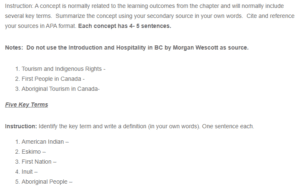Aboriginal Tourism
Aboriginal tourism refers to a pivotal component of tourism that gives visitors a chance to experience an authentic cultural experience. The center of attraction for Aboriginal tourists is Aboriginal territories, the custodians of the culture that draws tourists’ interests. National and international laws exist that protect the territory and heritage of Aboriginal custodians. For instance, they are allowed to dress in a way that promotes their culture. No development activities are allowed within aboriginal territories if such developments will destroy their heritage. The interest in aboriginal tourism is attributable to tourists’ interest in exploring new cultures, traditions, and food, among other customs.
Three Concepts
-
Tourism and Indigenous Rights
The UN introduced tourism and indigenous rights to protect indigenous populations and their interests (Carr et al., 2016). The concept was introduced following protracted periods of injustices towards the indigenous people. Some of such injustices include land theft, economic suppression, and the appropriation of cultural expressions, such as art pieces. Unlike in the past, when the government only represented people’s interests, the new UN policy framework requires people’s direct input before making critical decisions. For instance, if investors are seeking to build a tourist hotel on forest land, the local community in that area must approve the use of their indigenous land.
-
First People in Canada
The First people in Canada are also referred to as the Aboriginals or the native people of Canada. Diverse histories, ceremonies, languages, and traditions characterize them. As per the Canadian Constitution Act, the First People include the Inuit, Metis, and the First Nations. Despite the hard economic and social changes that have characterized the latest decade, the First People have successfully protected their heritage. There have been efforts in Canada to protect the appropriation of Aboriginal people’s cultural heritage from European interests, thus boosting tourism.
-
Aboriginal Tourism in Canada-
The concept of Aboriginal tourism in Canada came up following a protracted period of tourism commercialization, with some tourism-oriented developments destroying tourist heritage. Legislation was enacted, leading to the formation of an Aboriginal Tourism Team, whose primary responsibility is to regulate Aboriginal Tourism at national and provincial levels. The Aboriginal Tourism Association of Canada now performs the team’s functions. Efforts made under the association have significantly boosted Aboriginal tourism. The sector is now a mainstream employer and contributes significantly to the national basket (Graci, 2010). A failure to recognize the tourism value offered by the community would have led to the destruction of part of its heritage.
Five Key Terms
- American Indian – American Indian is a term widely used to describe the first people in the United States, and it is acceptable to date, the same as native Indian, which is largely rejected by Aboriginal communities in Canada.
- Eskimo – Eskimo is a term that was traditionally used by non-Inuits to describe Inuits, but it is now considered inappropriate.
- First Nations – The First Nations are part of the Aboriginal People of Canada who do not identify as Inuits or Metis, have lived in Canada for hundreds of years, and identify with different customs and cultures.
- Inuit – Just like the First Nation, the Inuit also identify with the Aboriginal People, have lived in the Arctic region for long periods, and rely on sea and land resources for economic prosperity.
- Aboriginal People – The Aboriginal People are Canada’s constitutionally recognized indigenous people, including the First Nations, Inuit, and Metis.
References
Carr, A., Ruhanen, L., & Whitford, M. (2016). Indigenous peoples and tourism: the challenges and opportunities for sustainable tourism. Journal of Sustainable Tourism, 24(8-9), 1067–1079. https://doi.org/10.1080/09669582.2016.1206112
Graci, S. (2010). The potential for Aboriginal ecotourism in Ontario. In Geography Research Forum (Vol. 30, pp. 33-148).
ORDER A PLAGIARISM-FREE PAPER HERE
We’ll write everything from scratch
Question
Instruction: A concept is normally related to the learning outcomes from the chapter and will normally include several key terms. Summarize the concept using your secondary source in your own words. Cite and reference your sources in APA format. Each concept has 4- 5 sentences.

Aboriginal Tourism
Notes: Do not use the Introduction and Hospitality in BC by Morgan Wescott as a source.
- Tourism and Indigenous Rights –
- First People in Canada –
- Aboriginal Tourism in Canada-
Five Key Terms
Instruction: Identify the key term and write a definition (in your own words). One sentence each.
- American Indian –
- Eskimo –
- First Nation –
- Inuit –
- Aboriginal People –

